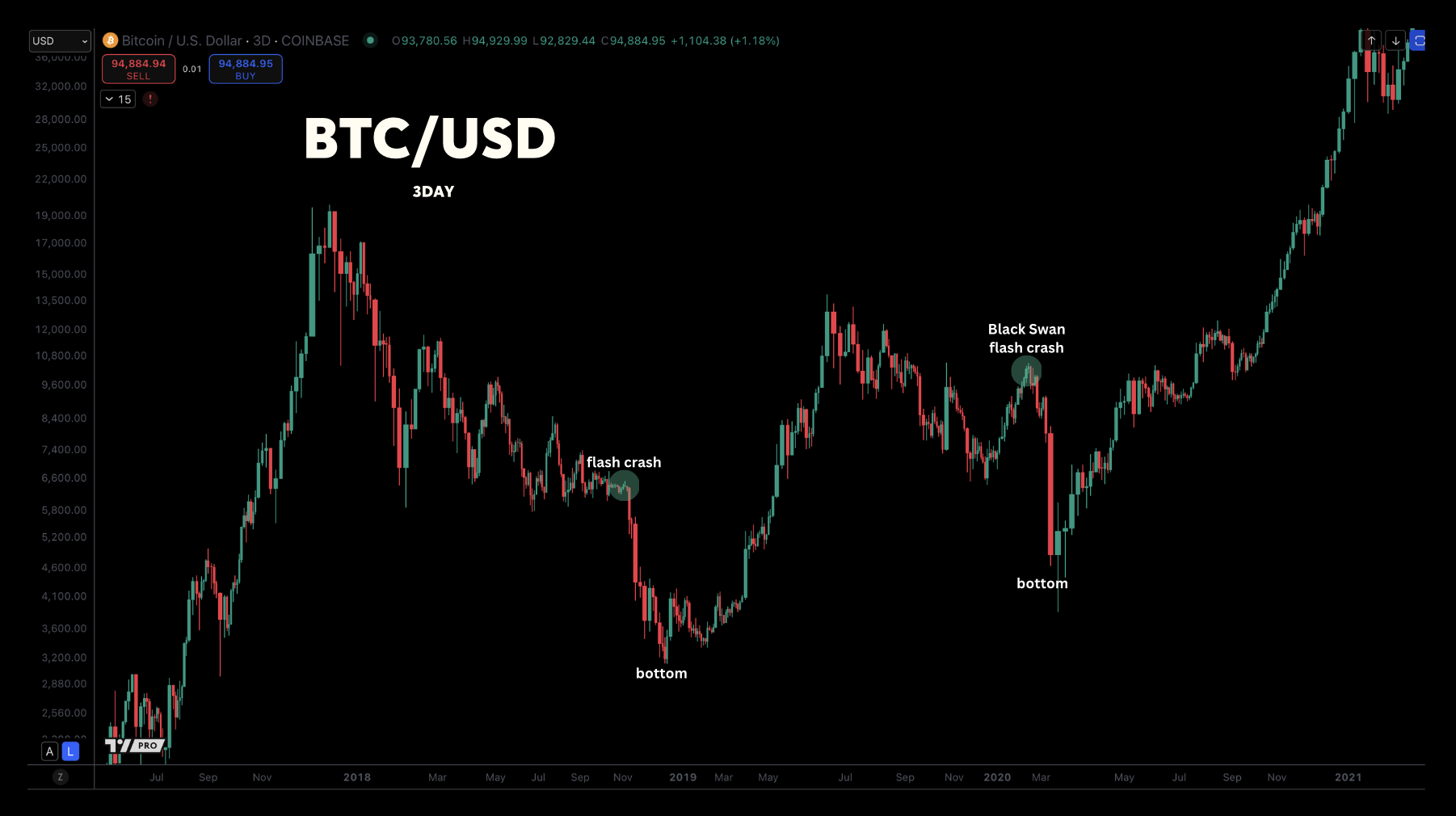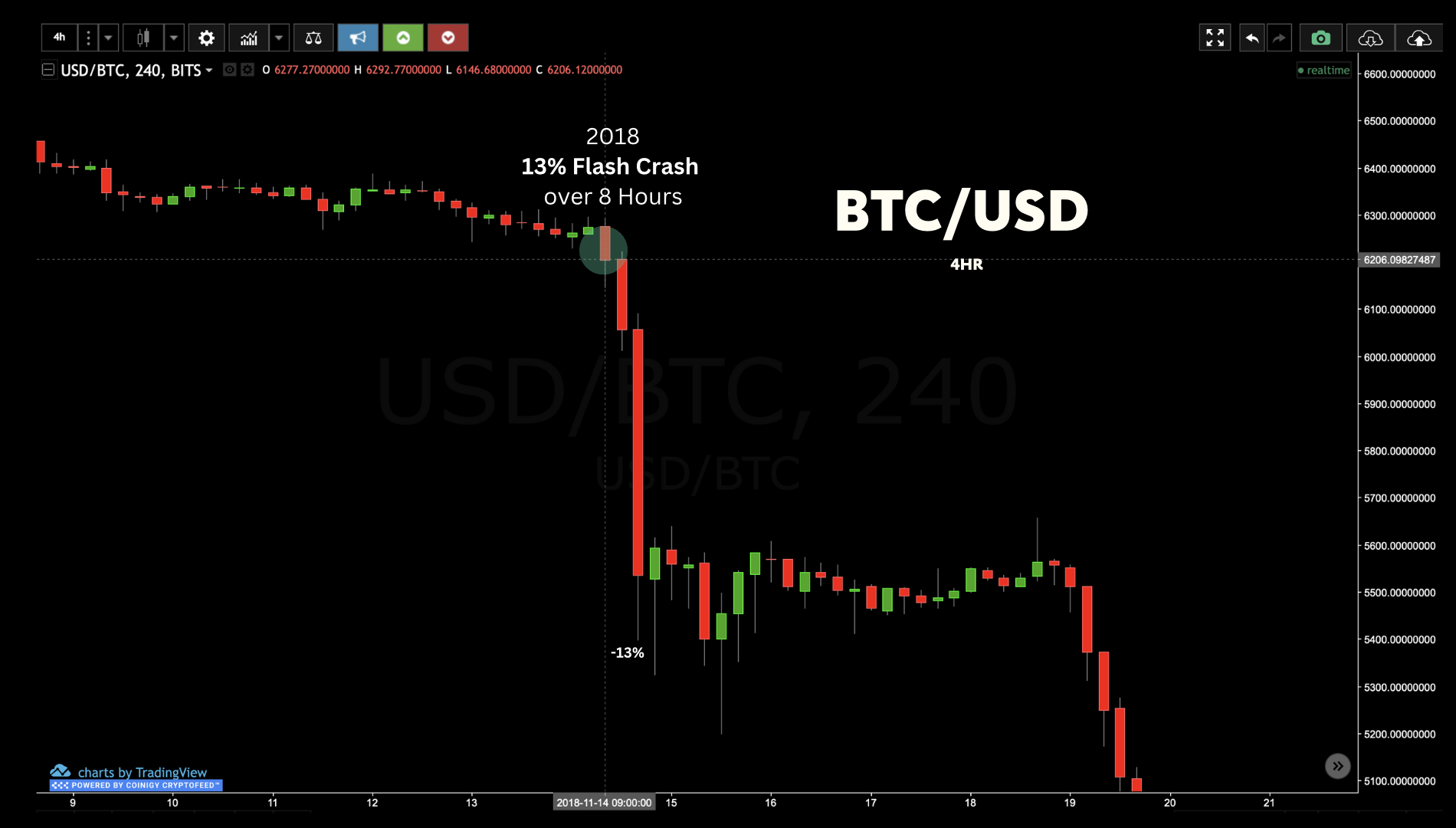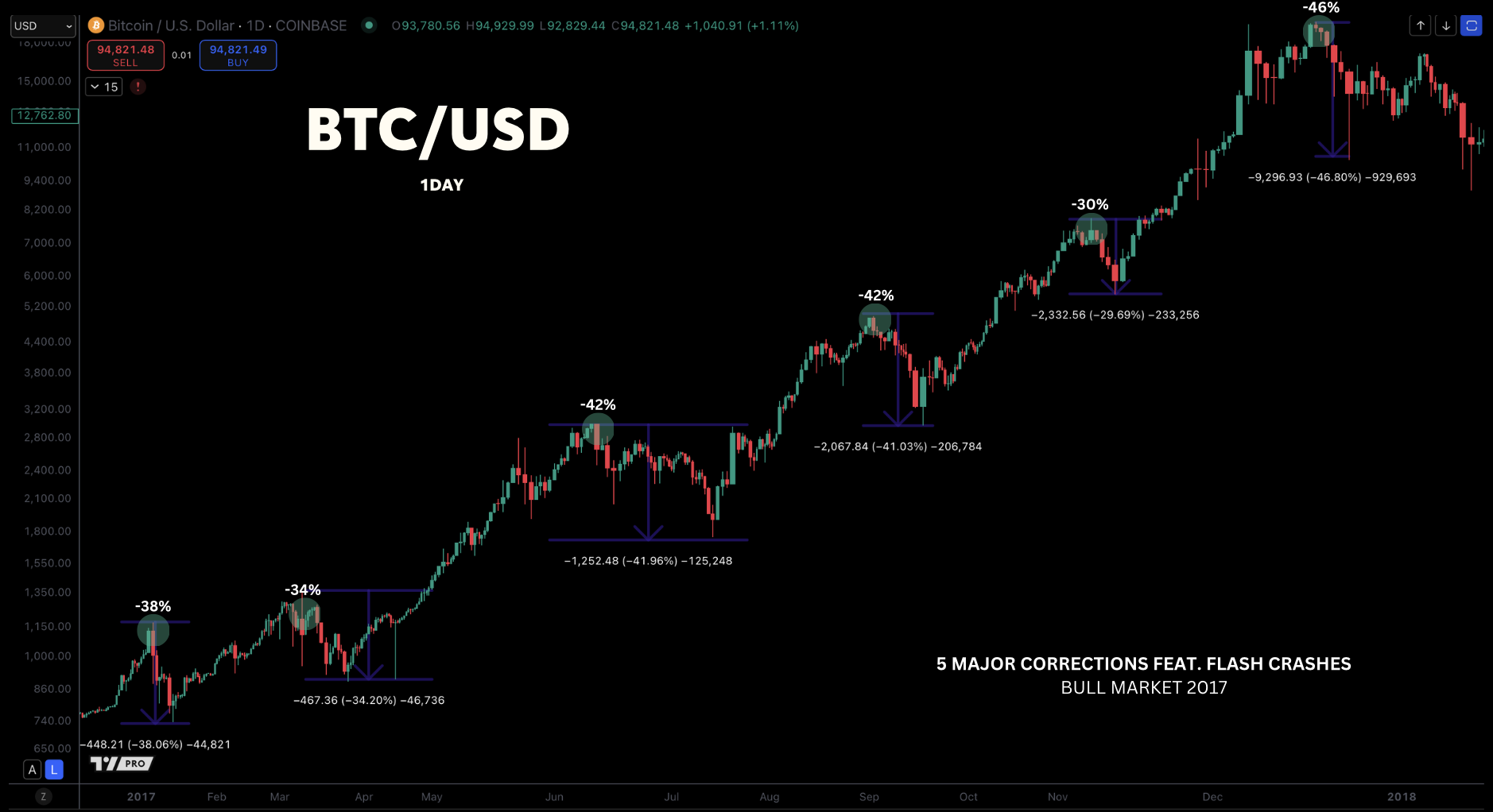Bitcoin's Sudden Plunge: Understanding the Causes, Examples, and Safeguards
Key Takeaways
- Frequent sudden drops in Bitcoin’s value typically reveal underlying vulnerabilities in the market; however, they have traditionally presented chances for savvy and enduring traders to capitalize on these situations.
- Each significant Bitcoin flash crash throughout history has ultimately been succeeded by a new record-high price.
- Flash crashes often happen following steep upward movements or feeble sideways trends, providing opportunities at reduced prices for traders who are ready.
- The abrupt flash crashes of Bitcoin can largely be attributed to liquidity shortages, leveraged positions being liquidated, and automated trading bots executing sales.
A Bitcoin flash crash is a sudden and steep drop in BTC's price that happens within minutes or hours. It typically occurs when selling pressure overruns available buyers, causing prices to collapse before stabilizing.
Flash crashes are an inherent characteristic of Bitcoin's volatility. volatility This piece will assist with understanding liquidity dynamics. traders expect sudden sharp drops in prices and proactively position your orders near crucial support or resistance levels prior to increased market turbulence.
Main Factors Leading to Bitcoin Value Plunges
Sudden failures in software appear due to multiple causes, such as:
- Liquidity vacuums During times when the order book has limited liquidity, relatively small sell orders can lead to significant price declines. Bitcoin's price .
- Leverage unwinds Over-leveraged traders encountering forced sales trigger a series of fire-sales, exacerbating BTC's rapid price declines.
- Stop-loss clustering Clusters of mispositioned stop-loss orders act as attractors, exacerbating the downward trend.
- Algorithmic trading failures Bots responding to sudden volatility can intensify downward trends, particularly when liquidity decreases.
- Black swan events : External shocks Events like regulatory crackdowns or macroeconomic crises can trigger widespread panic.
How to Trade Bitcoin During Flash Crashes: Identifying Possibilities When Markets Panic
Flash crashes reveal weak spots in the market, where prices move up too quickly without building a solid foundation. When selling pressure rises, these weak spots give way fast, causing sharp drops.
For traders interested in building a strategy around Bitcoin flash crashes, the Quickfingersluc (QFL) method — also known as the Base Strategy — is worth understanding. It was developed by a Canadian trader named Luke.

QFL helps traders identify high-chance entry opportunities during sudden market drops, enabling them to purchase assets amid panic, control risks better, and set up for robust recoveries without following the overall market trend.
How Algorithms and Bots Play a Role in Bitcoin Sudden Plunges
Automated Trading systems can exacerbate flash crashes through various mechanisms:
- High-frequency withdrawals : Bots rapidly pull bids when volatility increases, draining liquidity.
- Liquidation cascades Programmed margin calls sell off leveraged positions, exacerbating the situation selling pressure .
- Reactive selling Bots following momentum might mistakenly view technical breakdowns as trend reversals, thereby amplifying market movements.
Strategies to Safeguard Your Investments When Bitcoin Experiences Rapid Drops
Safety starts prior to the collision, not when it happens. Essential tools encompass:
- Pre-placed limit orders: Placing limit orders close to earlier price levels or key support areas might assist traders in securing more advantageous entry points when sudden market drops occur.
- Strategic stop-loss placement: Placing stop-loss orders away from major liquidity areas minimizes the chance of getting forced out prematurely due to abrupt market fluctuations.
- Price notifications at important thresholds: By employing alerts rather than automated responses, traders can manually evaluate the circumstances. key technical points .
- Long-term holdings cold storage: Keeping long-term investments in cold storage avoids impulsive choices during intense market crashes.
Strategies for Managing Risk Amid Bitcoin’s Fluctuations
Successfully trading Bitcoin’s fluctuating prices for profit necessitates knowledge of risk management, which encompasses:
- Size positions carefully: Maintain moderate position sizes compared to your total portfolio so you can handle significant fluctuations without worry.
- Take partial profits: Sudden drops frequently occur following steep upward surges; securing profits progressively shields you against abrupt downturns.
- Study market structure: Recognize when prices move significantly beyond reliable support levels—markets that surge rapidly tend to be more susceptible to significant reversals. TD Sequential serves as a metric tracking time and momentum, aiding in pinpointing moments when prices might be exhausted.
- Limit or avoid leverage: Applying leverage may exacerbate losses during flash crashes, typically resulting in compulsory sell-offs when market conditions are most unfavorable.
- Prepare emotionally: Establish your exit and entry strategies during periods of market tranquility, allowing for confident execution when volatility strikes.
Bitcoin Sudden Plunge: Insights from the 2018 Downturn and the $6,000 Drop Out
Throughout Bitcoin's history, rapid plunges in value have frequently occurred. market cycle Some notable instances include the 2018 drop where the market fell by 13% over eight hours.
The 2018 Stock Market Flash Crashes
In November 2018, Bitcoin underwent a sudden steep decline where its value dropped by 13% within merely eight hours. Following several months of trading near the $6,000 mark, Bitcoin eventually plummeted below this key support level. psychological and technical support.

The sell-off initiated a series of liquidations, stop-loss triggers, and frantic sales, which sped up the downturn. After the support level at $6,000 was breached, purchasers retreated, causing the market to swiftly plummet into the lower $5,000 territory.
This sudden plummet signaled the conclusion of the 2018 consolidation phase and paved the way for Bitcoin’s further decline into a more severe bear market trough around $3,100 within a matter of weeks.
Significantly, even though the intensity of the downturn was severe, this surrender marked a trough that ultimately initiated Bitcoin’s subsequent significant bullish phase. Historically, it turned out to be a strategic time for investment. accumulate Bitcoin after seller exhaustion.
Bitcoin Sudden Plunges Are Not Abnormalities — They Are Inherent
Flash crashes are not aberrations; they are an integral part of Bitcoin ' s inherent price discovery mechanism. Although these can cause volatility in the short term, they frequently pave the way for robust, more enduring trends. Examining their patterns assists dealers in staying consistent with the major trend instead of acting on emotions.

During the 2017 bullish phase, Bitcoin went through multiple significant declines ranging from 30% to 48%. However, every time, the market rebounded within just a few weeks and surged to unprecedented levels. Historical data indicates that such turbulence frequently eliminates less resilient investors but tends to benefit those who remain steadfast and maintain their focus on long-term trends.
Advantages of Bitcoin Sudden Drops for Investors
- Discounted entry points: Bitcoin flash crash events present chances to acquire the cryptocurrency at reduced prices avoiding steep upward movements.
- Market reset: They eliminate excessive debt and remove weaker participants, which makes the market more robust for lasting expansion.
- Clearer support levels: Frequent flash crash incidents create robust support areas which traders can utilize for upcoming trading strategies.
- Faster price discovery: Rapid declines accelerate the market cycle, resulting in faster rebounds and the emergence of new trends.
Conclusion
Bitcoin’s market dynamics frequently include rapid price drops known as flash crashes, which result from factors such as uneven supply and demand, shortages in liquidity, and panicked sell-offs. Despite their speed and shock value, these flash crashes typically present trading opportunities for those who are well-prepared beforehand.
By pinpointing fragile market structures and placing limit orders with risk management in focus, traders can transform volatility into a benefit.
During previous cycles, such as in 2017 and 2018, individuals who remained calm through sudden market drops found themselves well-placed to take advantage of Bitcoin’s upward trajectory over time.
FAQs
While precise timing remains elusive, signs of structural weaknesses can make flash crashes somewhat foreseeable.
Utilize limit orders, set up alerts, implement strategic stop-losses, and refrain from using leverage particularly when markets are excessively overextended.
Indeed, seasoned traders can seize opportunities by getting ready beforehand for potential Bitcoin flash crashes.
Are you able to forecast Bitcoin sudden drops?
What steps should I take to safeguard my cryptocurrency holdings during Bitcoin flash crashes?
Do Bitcoin sudden drops present good chances?
0 Response to "Bitcoin's Sudden Plunge: Understanding the Causes, Examples, and Safeguards"
Post a Comment